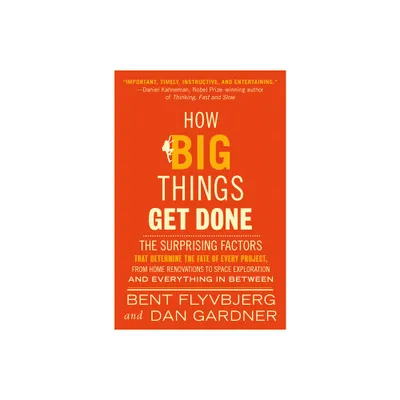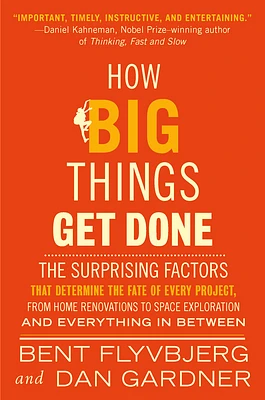Home
Cómo hacer grandes cosas / How Big Things Get Done
Loading Inventory...
Barnes and Noble
Cómo hacer grandes cosas / How Big Things Get Done
Current price: $22.95


Barnes and Noble
Cómo hacer grandes cosas / How Big Things Get Done
Current price: $22.95
Loading Inventory...
Size: Paperback
*Product Information may vary - to confirm product availability, pricing, and additional information please contact Barnes and Noble
Los secretos para planificar y llevar a cabo con éxito proyectos de cualquier envergadura, por el mayor experto munidal en megaproyectos.
Nada es más inspirador que una ambiciosa visión que se convierte en una realidad triunfante: el Empire State Building pasó de ser un boceto a cambiar el skyline de Nueva York en tan solo veintiún meses. Sin embargo, la mayoría de las veces las grandes visiones se convierten en auténticas pesadillas: según las estadísticas, un asombroso 92 por ciento de los megaproyectos superan el presupuesto o el cronograma, o ambas cosas. Incluso los esfuerzos más modestos, como emprender un pequeño negocio, suelen fracasar. ¿Por qué? El profesor de la Universidad de Oxford Bent Flyvbjerg ha dedicado su vida a comprender qué distingue a esos pocos triunfos entre tantos fracasos. En Cómo hacer grandes cosas identifica los errores de juicio y la toma de decisiones equivocadas que llevan al naufragio de los proyectos, ya sean grandes o pequeños. Y muestra cómo tus propios proyectos tienen más posibilidades de éxito si aplicas los principios que él mismo ha investigado durante décadas.
Repleto de inolvidables ejemplos que van desde la construcción de la Ópera de Sídney y la creación de los últimos éxitos de taquilla de Pixar, hasta la desastrosa reforma de una casa en Brooklyn, este libro es una guía indispensable para cualquier persona que planee un proyecto ambicioso.
ENGLISH DESCRIPTION
The secrets to successfully planning and delivering projects on any scale—from home renovation to space exploration—by the world’s leading expert on megaprojects.
“This book is important, timely, instructive, and entertaining. What more could you ask for?”—Daniel Kahneman, Nobel Prize-winning author of
Thinking
,
Fast
, and
Slow
“Over-budget and over-schedule is an inevitability. Incompetence and grift is outrageous. Bent Flyvbjerg, with this terrific data-driven book, has shown that there is another way.”—Frank Gehry
Nothing is more inspiring than a big vision that becomes a triumphant, new reality. Think of how the Empire State Building went from a sketch to the jewel of New York’s skyline in twenty-one months, or how Apple’s iPod went from a project with a single employee to a product launch in eleven months.
These are wonderful stories. But most of the time big visions turn into nightmares. Remember Boston’s “Big Dig”? Almost every sizeable city in the world has such a fiasco in its backyard. In fact, no less than 92% of megaprojects come in over budget or over schedule, or both. The cost of California’s high-speed rail project soared from $33 billion to $100 billon—and won’t even go where promised. More modest endeavors, whether launching a small business, organizing a conference, or just finishing a work project on time, also commonly fail. Why?
Understanding what distinguishes the triumphs from the failures has been the life’s work of Oxford professor Bent Flyvbjerg, dubbed “the world’s leading megaproject expert.” In
How Big Things Get Done
, he identifies the errors in judgment and decision-making that lead projects, both big and small, to fail, and the research-based principles that will make you succeed with yours. For example:
• Understand your odds. If you don’t know them, you won’t win.
• Plan slow, act fast. Getting to the action quick feels right. But it’s wrong.
• Think right to left. Start with your goal, then identify the steps to get there.
• Find your Lego. Big is best built from small.
• Be a team maker. You won’t succeed without an “us.”
• Master the unknown unknowns. Most think they can’t, so they fail. Flyvbjerg shows how you can.
• Know that your biggest risk is you.
Full of vivid examples ranging from the building of the Sydney Opera House to the making of the latest Pixar blockbusters, to a home renovation in Brooklyn gone awry,
reveals how to get any ambitious project done—on time and on budget.
Nada es más inspirador que una ambiciosa visión que se convierte en una realidad triunfante: el Empire State Building pasó de ser un boceto a cambiar el skyline de Nueva York en tan solo veintiún meses. Sin embargo, la mayoría de las veces las grandes visiones se convierten en auténticas pesadillas: según las estadísticas, un asombroso 92 por ciento de los megaproyectos superan el presupuesto o el cronograma, o ambas cosas. Incluso los esfuerzos más modestos, como emprender un pequeño negocio, suelen fracasar. ¿Por qué? El profesor de la Universidad de Oxford Bent Flyvbjerg ha dedicado su vida a comprender qué distingue a esos pocos triunfos entre tantos fracasos. En Cómo hacer grandes cosas identifica los errores de juicio y la toma de decisiones equivocadas que llevan al naufragio de los proyectos, ya sean grandes o pequeños. Y muestra cómo tus propios proyectos tienen más posibilidades de éxito si aplicas los principios que él mismo ha investigado durante décadas.
Repleto de inolvidables ejemplos que van desde la construcción de la Ópera de Sídney y la creación de los últimos éxitos de taquilla de Pixar, hasta la desastrosa reforma de una casa en Brooklyn, este libro es una guía indispensable para cualquier persona que planee un proyecto ambicioso.
ENGLISH DESCRIPTION
The secrets to successfully planning and delivering projects on any scale—from home renovation to space exploration—by the world’s leading expert on megaprojects.
“This book is important, timely, instructive, and entertaining. What more could you ask for?”—Daniel Kahneman, Nobel Prize-winning author of
Thinking
,
Fast
, and
Slow
“Over-budget and over-schedule is an inevitability. Incompetence and grift is outrageous. Bent Flyvbjerg, with this terrific data-driven book, has shown that there is another way.”—Frank Gehry
Nothing is more inspiring than a big vision that becomes a triumphant, new reality. Think of how the Empire State Building went from a sketch to the jewel of New York’s skyline in twenty-one months, or how Apple’s iPod went from a project with a single employee to a product launch in eleven months.
These are wonderful stories. But most of the time big visions turn into nightmares. Remember Boston’s “Big Dig”? Almost every sizeable city in the world has such a fiasco in its backyard. In fact, no less than 92% of megaprojects come in over budget or over schedule, or both. The cost of California’s high-speed rail project soared from $33 billion to $100 billon—and won’t even go where promised. More modest endeavors, whether launching a small business, organizing a conference, or just finishing a work project on time, also commonly fail. Why?
Understanding what distinguishes the triumphs from the failures has been the life’s work of Oxford professor Bent Flyvbjerg, dubbed “the world’s leading megaproject expert.” In
How Big Things Get Done
, he identifies the errors in judgment and decision-making that lead projects, both big and small, to fail, and the research-based principles that will make you succeed with yours. For example:
• Understand your odds. If you don’t know them, you won’t win.
• Plan slow, act fast. Getting to the action quick feels right. But it’s wrong.
• Think right to left. Start with your goal, then identify the steps to get there.
• Find your Lego. Big is best built from small.
• Be a team maker. You won’t succeed without an “us.”
• Master the unknown unknowns. Most think they can’t, so they fail. Flyvbjerg shows how you can.
• Know that your biggest risk is you.
Full of vivid examples ranging from the building of the Sydney Opera House to the making of the latest Pixar blockbusters, to a home renovation in Brooklyn gone awry,
reveals how to get any ambitious project done—on time and on budget.


















